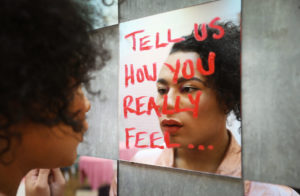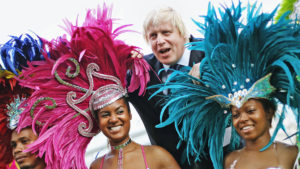Feminist heroine, Catholic martyr, patron saint of France, LGBTQ icon. During the nearly six centuries since she was burned at the stake, Joan of Arc has been many things to many people. Today is no exception: she’s causing a furore again, as the central figure in I, Joan, a new play in which she’s represented as “non-binary” and using “they/them” pronouns.
Feminists are outraged. Joan has long been treasured by the women’s movement, as a rare example of a woman who escaped her narrow allotted life and changed the course of history. One of the largest ever Suffragette marches, comprising some 40,000 women in 1911, was headed by a protestor dressed as Joan. For many in this camp, a “non-binary” reimagining of Joan isn’t “exploring gender”, but “an extension of the dull, patriarchal line that women don’t have a history”.
But it’s also true that — as Globe artistic director Michelle Terry argued in response to the uproar — reimagining and even fabricating history for new audiences is a noble tradition, with Shakespeare himself a leading exponent of the art. Shakespeare, Terry says, “did not write historically accurate plays… [but] took figures of the past to ask questions about the world around him. Our writers of today are doing no different.”
When Joan was born in 1412, France was roiled by the Hundred Years’ War: a bitter conflict with not only the English fighting for dominion of the country, but a parallel civil war between competing French ruling factions, the Armagnacs and Burgundians. The town across the river from Joan’s birthplace supported the Burgundians, while hers supported the Armagnacs. Children would come home bloody from fistfights over competing loyalties to Armagnac king or Burgundian duke. Meanwhile, most actual fighting was done by mercenaries, who prowled the countryside robbing peasants for food, fuel and treasure in lieu of the pay they seldom received.
The year Joan reached puberty, such a band swept through her village of Domrémy, stealing cattle and setting fire to the church. That was also when her visions began; three years later, she left home under a pretext and travelled to the French King, demanding to see him and offer her aid on the strength of her visions.
The broad outlines of what happened next are well-known. Joan, dressed in men’s clothing, was granted an audience with the French King Charles. Clad in white armour, she helped lead his troops to a number of victories, and marched with Charles through lands held by the hostile Burgundians to his coronation at Reims. She was eventually captured by the English and forced to recant, before changing her mind and proclaiming her beliefs, finally dying on a heretic’s pyre in 1431. Her mother Isabelle worked to clear her name; in 1456, she was declared a martyr; in 1920, she was canonised.
Shakespeare’s three-parter on Henry VI, which gives an account of the later part of the Hundred Years’ War from an English perspective, includes the figure of Joan. And what Terry politely calls asking “questions about the world” might more cynically be called Elizabethan ruling-class propaganda. Even 150 years after her death, a political enemy of England as significant as Joan couldn’t have been glamourised on an English stage, any more than the BBC could glamourise Vladimir Putin in a docudrama today.
Instead, for Shakespeare, Joan is a “trull” (Elizabethan for “slapper”) or “puzzel” (“filthy whore”) who summons legions of demons to aid her quest for victory over the English. After capture, she denies her own father (a heinous act in Elizabethan terms) before trying to avoid execution by claiming to be pregnant.
So if Elizabethan elites were fixated on England’s geopolitical fortunes, and reimagined Joan negatively in that light, it should be no surprise that today’s reinvention of her aligns with another central modern elite fixation: pretending we can identify our way out of biology. And in this sense, the Globe’s new production is a continuation of Shakespeare’s propagation of ruling-class ideology.
But reading the Bard’s heavily sexualised hatchet-job alongside other literary Joans — including the one currently causing all this fuss — also points to a broader question she raises: over how, as a woman, you can juggle your own desire to have political agency, and men’s desire to have… you. Even today, a young woman simply existing in a public space seems enough to prompt (at least some) men to look past whatever she’s trying to do and focus on trying to shag what she is. But the problem is an ancient one — and acutely difficult to navigate if you’re female and want to get anything done.
Joan is unusual among medieval female saints in how active she was: a more typical female saint might wall herself up in a cell as an anchoress, starve herself to death, or become a literary and musical polymath while running a convent. Few such figures engaged directly with the world, let alone in as kinetic a sphere as the battlefield. So it’s no coincidence that literary depictions of Joan that cast her in a negative light often do so, as in Shakespeare, by questioning her chastity. Take Voltaire’s La Pucelle D’Orleans, a racy 1730 poem in which Joan is nearly seduced by a flying donkey, and which so scandalised the satirist’s peers that it wasn’t published until 1899. In brief: for women, to the extent that you’re perceived as fuckable, you’re neither a worthy opponent nor a feasible brother-in-arms.
Among women on a mission, the response until recently has been to remain sexually unavailable. This strategy long predates the medieval Christian emphasis on chastity: in Greek myth, it’s epitomised by the Amazons, reportedly tattooed, pot-smoking Scythian warrior women dedicated to Artemis, goddess of hunting, chastity and war. The Amazons were said to wear trousers, cut off one breast to use a bow better, and keep men only for procreation and slave labour. And their unavailability was key to their power: when the Amazons are defeated it tends to be associated with one of them falling in love with a man. In the legend of Heracles, for example, the Amazon queen Hippolyta willingly gives him her “girdle”, only for the other Amazons to be roused to attack by the goddess Hera, in which struggle Hippolyta is killed.
Hippolyta appears, too, in Shakespeare’s work — except that in A Midsummer Night’s Dream, she’s been defeated by Theseus, stripped of her weapons and is now a charmingly submissive bride-to-be. The context has led some critics to suggest the Bard was dropping heavy hints that, as many at the time believed, the reigning monarch Elizabeth I should get married and do as her husband told her.
But Elizabeth never married, and — like Joan — instead made virginity a key part of her personal brand. Rather than risk the inevitable arguments about whether or not she should obey her husband, she danced nimbly across legal and social convention concerning sex roles, monarchy and authority, referring to herself as “queen”, “king” and “prince” as well as “woman” and “virgin”.
Historian Marina Warner has claimed that Joan was driven to angry tears by the taunts her English enemies flung at her, calling her virginity into question. She, like Elizabeth, understood the lesson of the Amazons: mixing sexual action with the military kind tends to go badly for the woman. But where Joan and Elizabeth solved this by building a public persona around chastity, I, Joan perfectly captures the 21st-century alternative strategy. Instead of safeguarding female agency at the cost of sexuality, we must now pretend that it’s possible to retain both sexuality and agency, by opting out of being female.
In two narrow senses, then, a “non-binary” Joan is profoundly conservative. Firstly, it’s the latest in a very long line of literary reworkings of an ambiguous historical figure, in light of contemporary high-status beliefs. (Here, too, Elizabeth has also now also been retrospectively rendered “non-binary”, for the skilful ambiguity with which she navigated her unusual constitutional role as female wielder of an authority exclusively reserved for males.) It couldn’t be more fitting that I, Joan should be staged at the Globe, modern replica of a theatre where Shakespeare himself re-imagined Joan to propagandise for a different set of ruling-class political priorities four centuries ago.
Secondly, this reimagining is implicitly conservative in the downbeat answer it offers to a problem as old as recorded human history: that of war, sex and women’s agency. Can women both fight and fuck, without suffering the fate of Hippolyta? What we learn both from Joan, and later from Elizabeth, is that you can get some way with strategic androgyny. But the Amazons also teach us that wherever agency and femaleness collide, the key is in staying unavailable: if you put out, or are even perceived to put out, the game is up. And the miserable interpersonal chaos of #MeToo, along with its negative aftermath for women’s productivity, suggests that even today this remains somewhat true.
Opting Joan (and indeed Elizabeth) out of this mess by claiming to have transcended sex is, in effect, to stick one’s fingers in one’s ears in the hope that this asymmetry will go away — or at least in the hope that it’ll enable those females who opt for this strategy to enjoy personal agency without having to opt out of having sex.
Does this work? Well, maybe, in a way, but more in the sense of displacing or mystifying than abolishing sexed dynamics. I struggle to believe that “non-binary” Joan would be depicted on theatre posters naked from the waist up save for a dirty binder were she a male rather than a female “non-binary”. Even those officially committed to “queering” the past still know perfectly well which type of undressed body draws the eye.
And between all these lines today, we can just about read the real taboo: one that’s emphatically not about “queering” gender, a move that could not be more tediously Establishment in 2022. Rather, it’s the noble “no” at the heart of the Amazonian mythos, as well as Joan’s extraordinary blend of high spirituality and military action, and Elizabeth I’s political persona. It is the only form of specifically female power that’s truly culturally off-limits today: virginity.
Disclaimer
Some of the posts we share are controversial and we do not necessarily agree with them in the whole extend. Sometimes we agree with the content or part of it but we do not agree with the narration or language. Nevertheless we find them somehow interesting, valuable and/or informative or we share them, because we strongly believe in freedom of speech, free press and journalism. We strongly encourage you to have a critical approach to all the content, do your own research and analysis to build your own opinion.
We would be glad to have your feedback.
Source: UnHerd Read the original article here: https://unherd.com/




